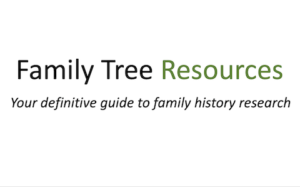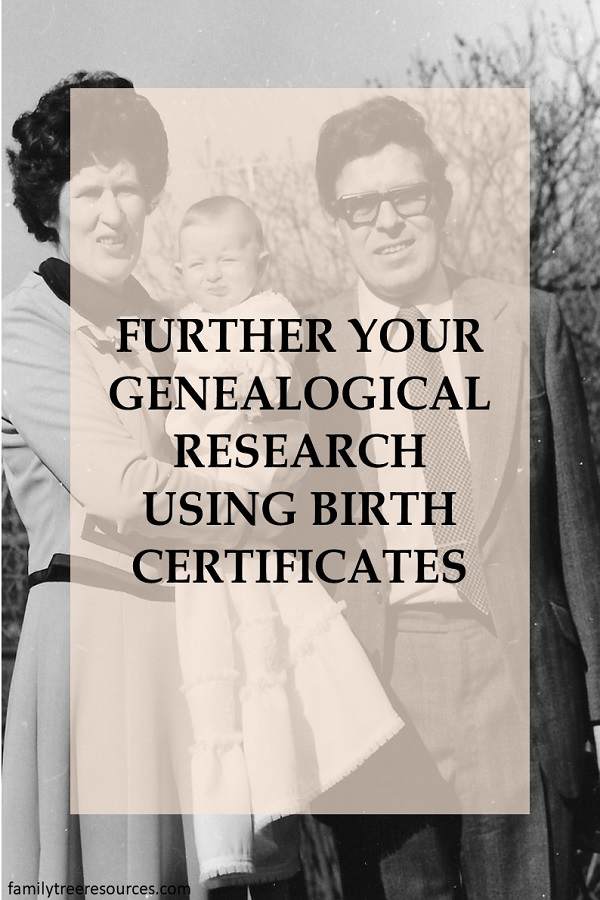
A birth certificate is an official record of a birth, but it did not exist until 1st July 1837, when civil registration began.
After 1875, parents were, and still are to this day, required to register a birth within six weeks, or face being fined for non-submission of this information.
To obtain a birth certificate, you must first find the correct GRO Index reference number from the GRO Index, which is the national record of births, marriages and deaths.
The GRO has re-indexed the births section of the index up to 1934 (also 1984-2020), and now usually includes the maiden name of the mother from 1837.
Obtaining a certificate is very important because it can help you to associate a child with their correct parent(s).
If you have an ancestor who has a very common name such as Smith it can take on even more significance.
There are numerous John Smith’s in the GRO Index in any given year, and it is essential to make sure you have found the correct entry.
Short and Long Versions of a Birth Certificate
The short version of a birth certificate only gives the name of the child, its sex, birthplace and date of birth, so does not help with genealogical research.
It is advisable to get a long birth certificate as it provides more information, such as the parents’ name(s) and the mother’s maiden name so you can look for any possible marriage registration in the GRO Index.
Once you have found the marriage registration, you can order the marriage certificate.
Sometimes, however, you may find that although the parents of the child state that they were married when the child was born, that was not always the case.
My ancestors William Baker and Elizabeth Hill stated that they were married and had several children together, but I have never been able to find a marriage for them. Elizabeth went on to marry William’s brother Charles in 1928, declaring herself to be a spinster.
Confusing Birth Certificate
The certificate for Harriet Cole, who was the daughter of Samuel and Elizabeth Cole (formerly Barker nee Dammant), is confusing because it does not state Barker was not her maiden name, but her former married name, her first husband William Barker having died in 1833.
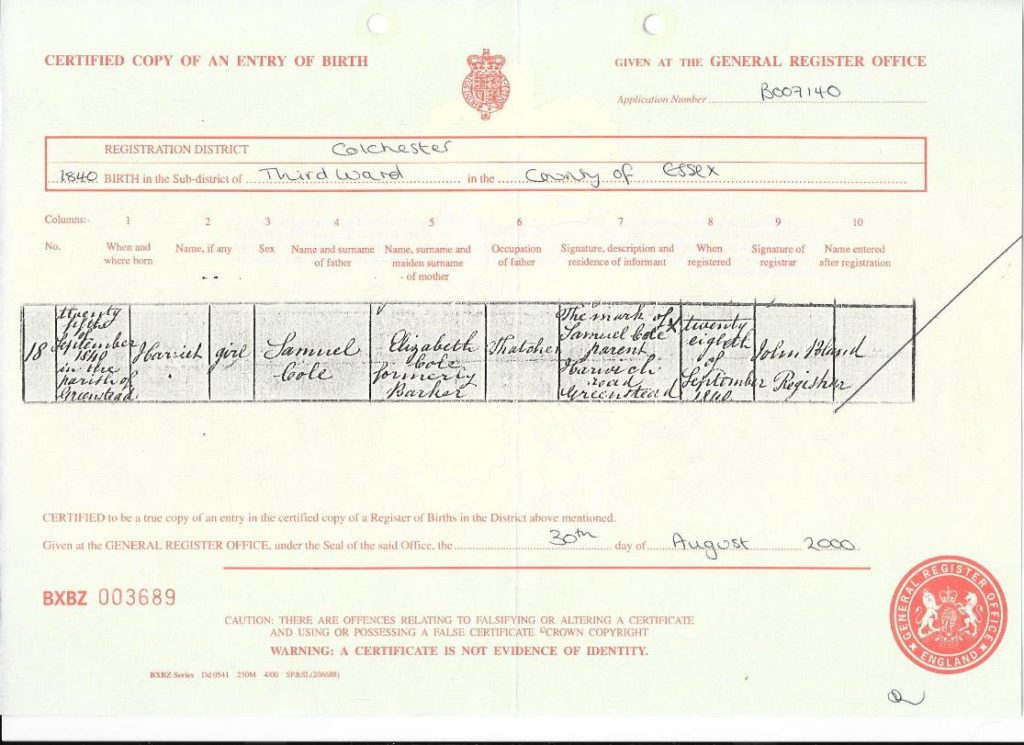
Information on a Birth Certificate
Registration District Where Birth Took Place
The heading of the birth certificate lists the registration district, sub-district if applicable, and the name of the county.
If a child was born in a rural area, their birth may have been registered in a registration district some miles from the village.
A large registration district has many smaller sub-districts; in the example birth certificate below, Northampton is the registration district whereas All Saints is the sub-district.
Entry Number in the Birth Register
The number written in the first column on a certificate is the entry number in the register. Although you only obtain one certificate, there are actually 5 entries per register page.
If twins are born, they will normally share the same entry number, but if they are on consecutive pages, they will have different reference numbers, e.g. 30 and 31.
This can sometimes be problematic, however, because if you are searching for a common name like Smith, you may find that there are two entries on the same page that are not actually related to each other at all.
Column 1 – When and Where The Child Was Born
The next column on a birth certificate lists the date of birth of the individual and their place of birth. If this was in a town, the street address was sometimes recorded, but if the birth took place in a village, only the village name was usually entered.
Although you might not think so, one of the most important pieces of information on a certificate that is often overlooked is the address.
This is crucial because it may mean you are able to find your ancestor on a census return, especially if you have not found them in a census index, which could lead to you discovering other information about them and their family.
If the birth took place in the workhouse, that is normally the address that is given by the master of the workhouse when he registered the birth.
If the child was illegitimate, and the mother lived in a village, she may have journeyed to a town to give birth because of the stigma and shame attached to having an illegitimate child at the time.
Please bear in mind that the address given is only the address of where she was living at the time of the birth and may not necessarily be her permanent address.
Column 2 – Name Given at Time of Birth, if any
This column detailed the full name of the child, but in some cases the parents had not yet named them, so this was occasionally entered as male or female.
The name a child was given at birth may not be the name they became known as. If the child was baptised as a Christian within 12 months after their birth was registered, the name in the register could be changed to reflect this.
If a person has two forenames, it was not uncommon for the person to change their order. Nora Alice could become known as Alice Nora, or they could drop a name altogether.
If a child was illegitimate, as was the case for my ancestor William Carrington Baker, you may find that the name given to the child at the time of their birth gives you a clue as to the identity of the father.
William’s birth was registered as William Baker Carrington in Apr-Jun 1852 (born 6 June 1852), his mother Elizabeth Carrington not marrying the father William Baker until 27 March 1856. William Baker Carrington later became known as William Carrington Baker.
Another example is that of Kate Mary Richardson Dadson, born on 10 May 1855, and Albert John Richardson Dadson, born in Apr-Jun 1857, died on 31 October 1857.
Their mother Mary Ann Dadson did not marry James Richardson until 30 May 1859. Kate was known by the surname of Richardson in later life.
Column 3 – Sex of the Child Born
This column was where the gender of the child was recorded – until 1969, the certificate stated boy or girl, but after that date, male or female was entered.
If the parents decide to give their child an unusual name, it may not always be possible to tell the sex of the child.
If the parents were illiterate, and could not tell what was being written in the register, a mistake may have been made at the time of registration.
Column 4 – Name and Surname of Father
The father’s details were were required to be entered on the certificate when the parents were married to each other, with only one parent signing the register.
If the parents were unmarried, the father’s name and occupation were often left blank, as had been decreed by an Act of Parliament in 1836.
Act of Parliament 1836
And it be enacted that the father or mother of every child born in England… shall within 42 days next after the day of every such birth give information upon being requested so to do to the Registrar, according to the best of his or her knowledge and belief of the several particulars hereby required to be known and registered touching the birth of such child provided always that it shall not be necessary to register the name of any father of a bastard child.
Some registrars, however, entered the name of the father even when the parents were unmarried. The situation changed in 1850, with the law then stating that ‘no putative father is to be allowed to sign an entry in the character of Father’.
The Registration Act of 1875 stated that ‘the putative father of an illegitimate child cannot be required as father to give information respecting the birth.
The name, surname and occupation of the putative father of an illegitimate child must not be entered except at the joint request of the father and mother; in which case both the father and mother must sign the entry as informants.
If the parents were both in attendance at the register office, then the father’s name could be recorded on the certificate regardless of whether the couple were married or not. Both parents signed the register.
In 1953 the law changed and the father could be acknowledged even if the parents were unmarried.
Column 5 – Name, Surname and Maiden Surname of Mother
If the mother was unmarried, only her sole name was entered on the birth certificate, but if she was married, her married and maiden names were both recorded.
If she had been previously married, her previous married name may be entered, such as Mary Dunkley late Clarke formerly Reynolds, as shown in the example below. There are, however, pitfalls to take into consideration when studying this information.
Was the Wrong Surname Entered on a Birth Certificate?
Although a certificate contains a wealth of information, it can sometimes lead you to progress in the wrong direction. My ancestor, Elizabeth Dammant, married William Barker on 4 October 1815 in Greenstead, Essex, England.
After William’s death in 1833, she went on to marry Samuel Cole on 9 December 1836. She had a daughter, Harriett, with Samuel on 25 September 1840, but her name was stated as being Elizabeth Cole formerly Barker on Harriett’s birth certificate.
Had I not already found Elizabeth’s marriage to William Barker, this would have been very confusing, and could have led me to believe I was tracing the wrong family.
To make matters even more confusing, the maiden surname written on the birth certificate may not necessarily be the name the mother had at birth. If a child was born as Florence Adams and her mother had remarried a man called Davis, Florence may have used her stepfather’s name.
I have found three different surnames for Mary:
Minton – the birth of daughter Elizabeth in 1875
Pecker – her marriage to William Hill in 1876
Minton – the birth of son Thomas in 1877
Packer – the birth of son John in 1879
Packer – the birth of son James in 1881
I am still, even after 15 years, attempting to track down her birth registration, although I have tried all variants of Minton, Pecker and Packer.
Column 6 – Occupation of Father
The father’s occupation is also entered, which can prove useful to the family historian as you may find your ancestor was mentioned in records of a company he may have worked for.
Column 7 – Signature, Description and Residence of Informant
The informant of the birth is asked to confirm whether the information recorded on the certificate is accurate before signing the entry.
One problem with this, however, was that many people were not able to read and write, signing their name by ‘making their mark’ with an X. If a person could not read, they would not be able to tell if the information was recorded accurately or not.
The mother is usually the preferential informant because she knows that she is the child’s mother. The next preferred informant is the father if they are married. If the parents were unmarried, the father and mother both signed as informants.
If the mother or father do not sign the certificate as informants, it could also be someone who was present when the birth occurred. Please bear in mind that if the informant of the birth was only distantly related to the baby, or was not connected at all, that the information they gave may be inaccurate.
If the birth took place in the workhouse, the master of the institution could sign the certificate.
If the informant was illiterate, they just left their ‘mark’, which was usually an X signifying they could not read or write. Their name was written out for them so you could find the surname was written incorrectly.
Column 8 – When the Birth Was Registered
The date entered here is the date the birth was registered, not the child’s birth date. If a birth took place on 28th December 1860, but the date of registration was not until 10th January 1861, you will find that the registration was in January-March 1861, not October-December 1860.
To avoid the penalties payable for late submission of a registration, some parents may have changed the birth date of their child so that it was apparently registered in the time limit of 6 weeks.
Column 9 – Signature of Registrar
The signature of the registrar was entered in this column, but if there are two signatures, this may indicate that the birth was registered late or had been re-registered.
Column 10 – Name Entered After Registration
If the child’s name was changed after the initial registration, then the new names were entered in this column, but the surname of the child could not be changed.
If the child’s names were changed following their baptism, but the entry in the register was not changed, you will find that the the name the child went by is not necessarily that which is on their birth certificate.
Could a Child be a Twin?
If a time is listed on a birth certificate this means the parents may have had more than one child born at the same time, or could just be because the registrar wanted to record as much information as possible.
Example of a Birth Certificate
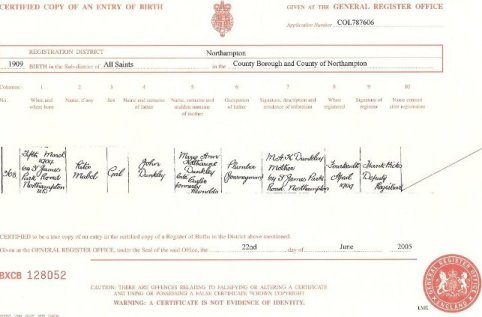
Birth Certificate Details at a Glance:
- Column 1 – When and where born
- Column 2 – Name, if Any
- Column 3 – Sex
- Column 4 – Name and Surname of Father
- Column 5 – Name, Surname and Maiden Surname of Mother
- Column 6 – Occupation of Father
- Column 7 – Signature and Residence of Informant
- Column 8 – When Registered
- Column 9 – Signature of Registrar
- Column 10 – Name Entered After Registration
How to Obtain a Birth Certificate:
It is possible to order a certificate from the ONS in Southport after you have found the birth registration in the GRO Index. You have to register on the GRO’s website before you can place an order or search through their index. Your email address, password and personal details should be entered.
You can ask the GRO to undertake a search on the national database if you are uncertain of the person’s date of birth. You can, however, conduct a search of the GRO Index on the GRO’s website for free if the person was born before 1935.
How to use the GRO’s Birth Index
To use the GRO’s birth index and order the certificate, you should follow the instructions below:
Enter https://www.gro.gov.uk
Click Order Certificates Online:
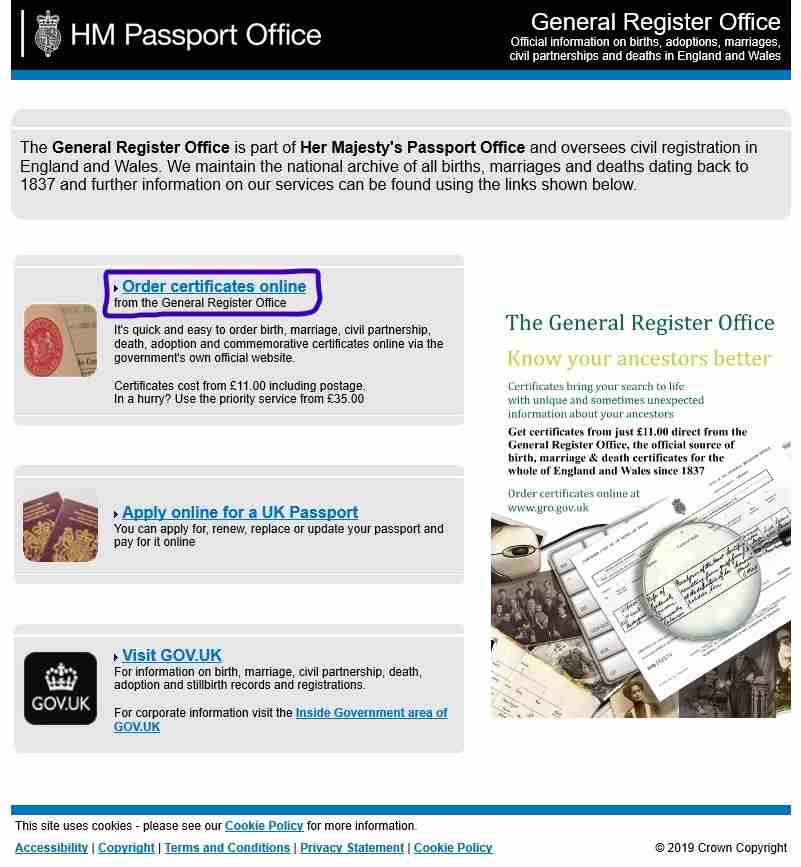
Click Register as an Individual:
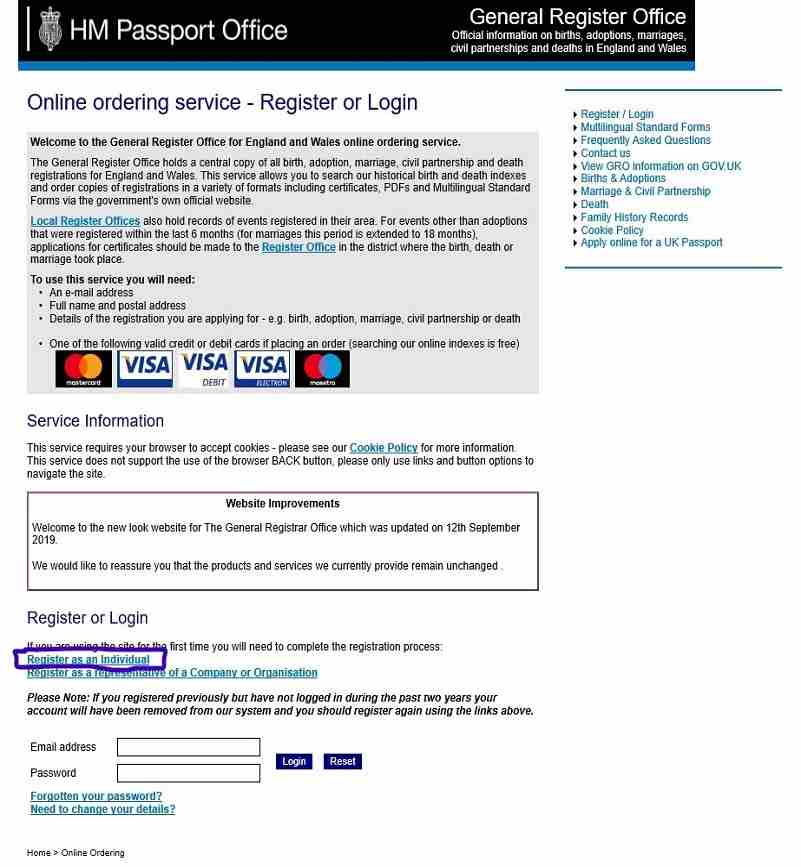
Enter your email address, password and personal details and agree to all the terms and conditions:
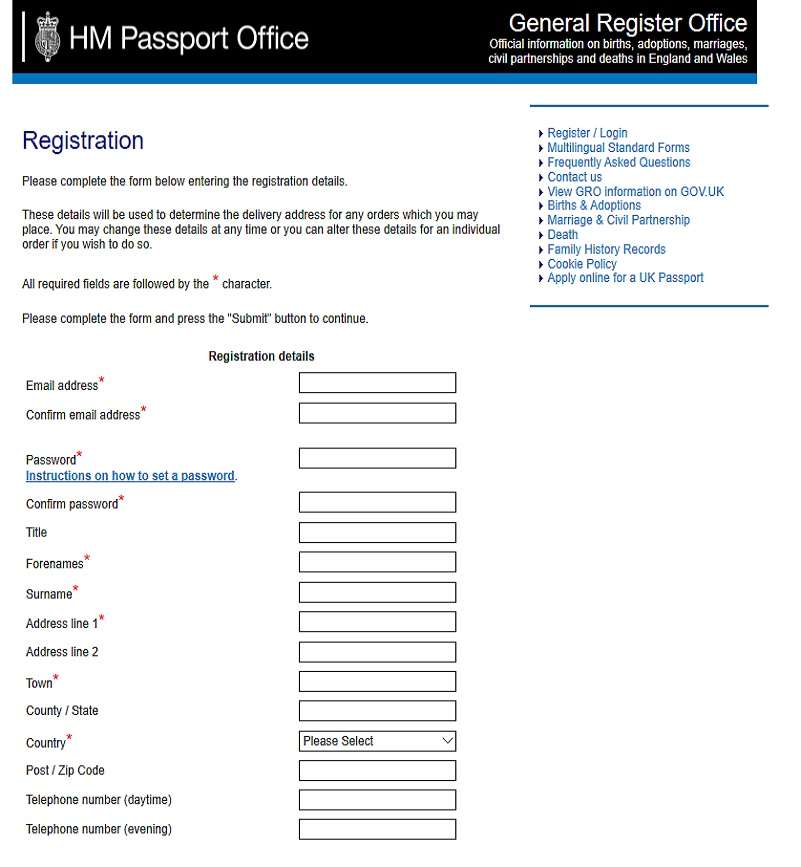
Click Activate Your Account:
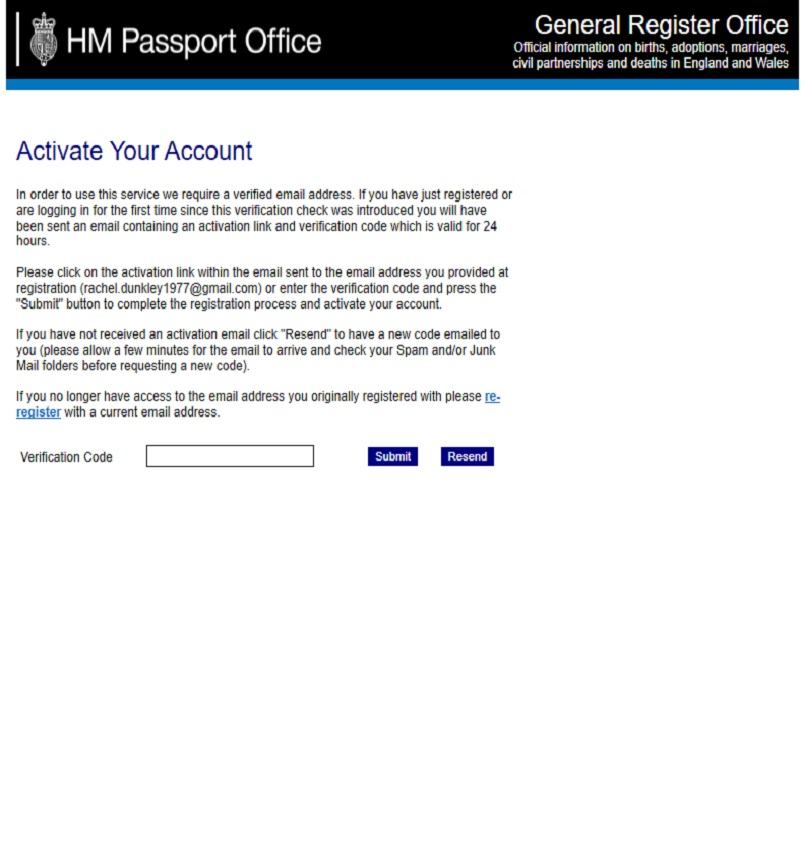
Click Search the GRO Indexes on the next screen following activation:
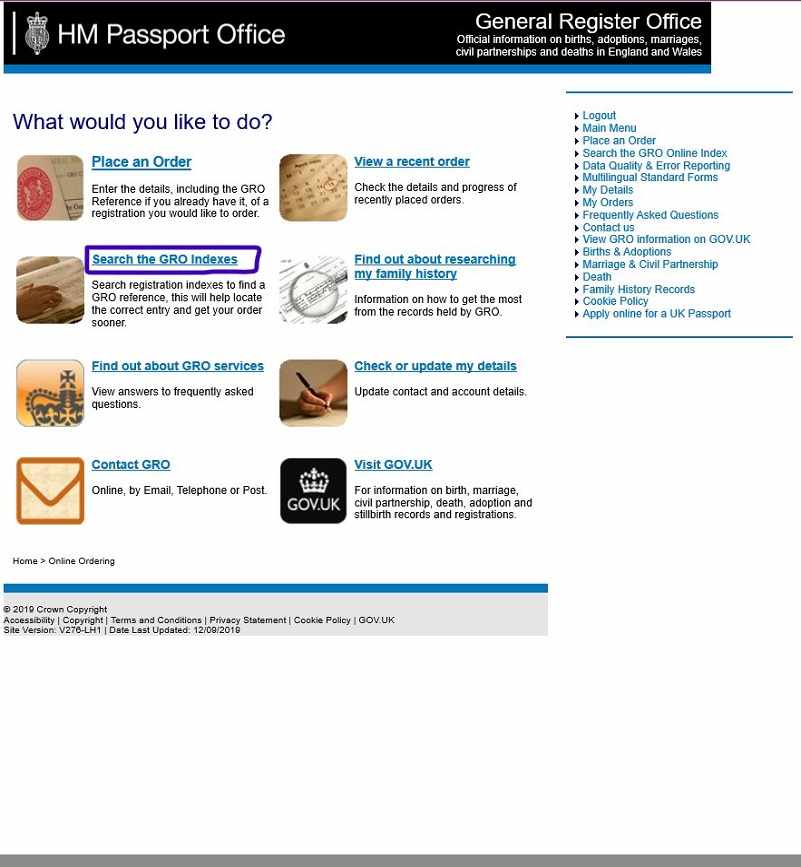
Click button next to births
Enter individual’s surname, gender and year of birth (you are able to search through a two year period, e.g. 1867 with a 2 year range will bring up 1865-1869. You can re-enter the search using different years if you cannot find the entry you are seeking)
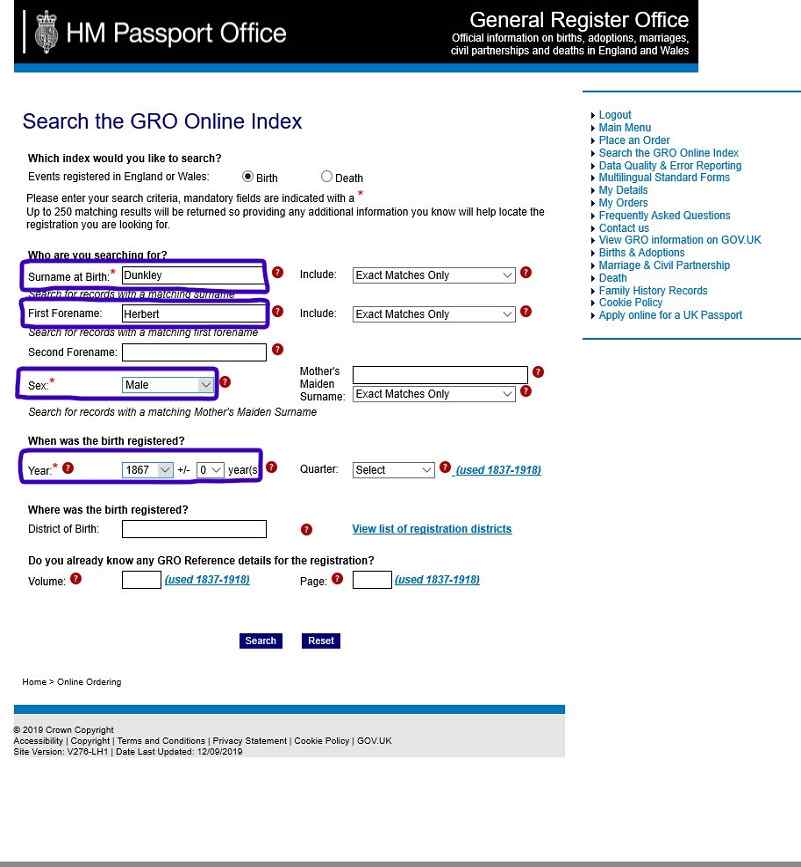
Click Search
Click button next to appropriate entry
Click PDF or Certificate (one is a download, one is sent through the post) (Information is entered on the form)
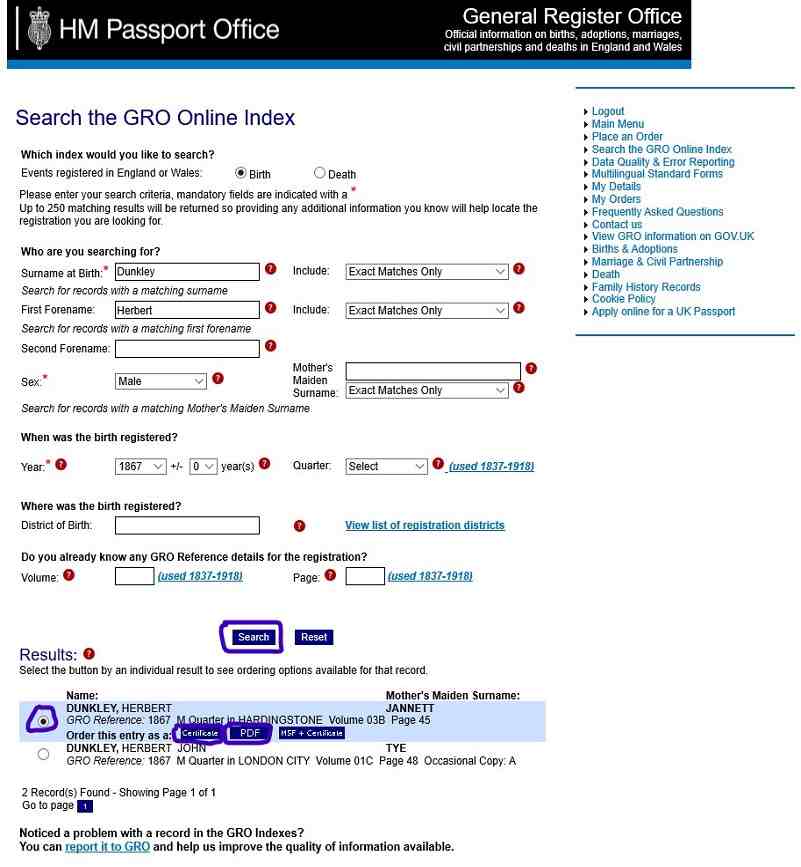
Click whether you wish to have a PDF version, Standard order (copy by post), or Priority Order (copy by post)
Click Submit
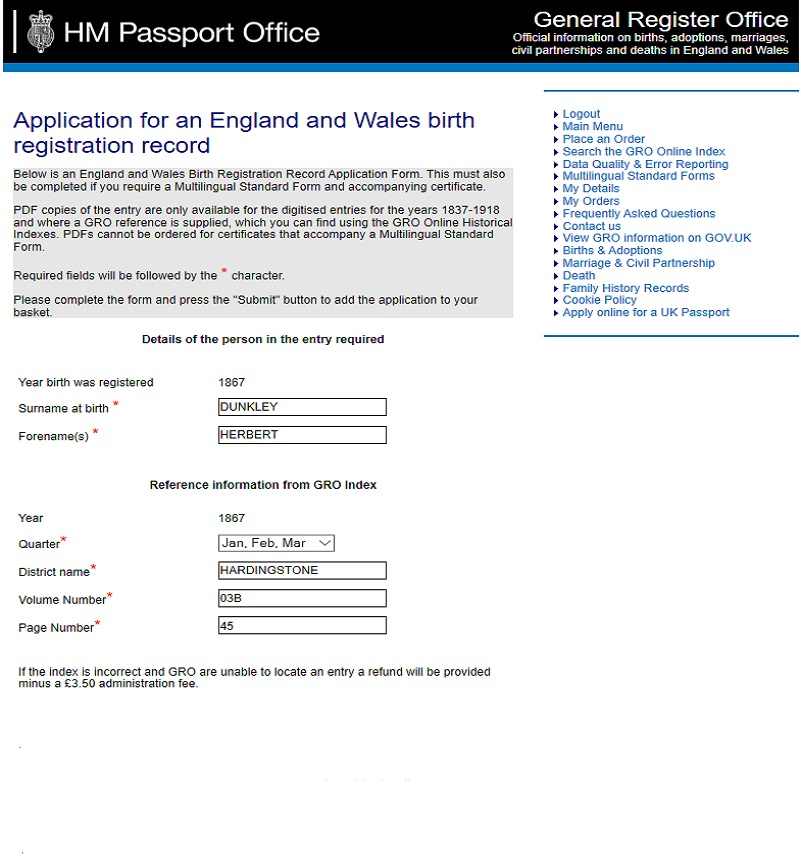
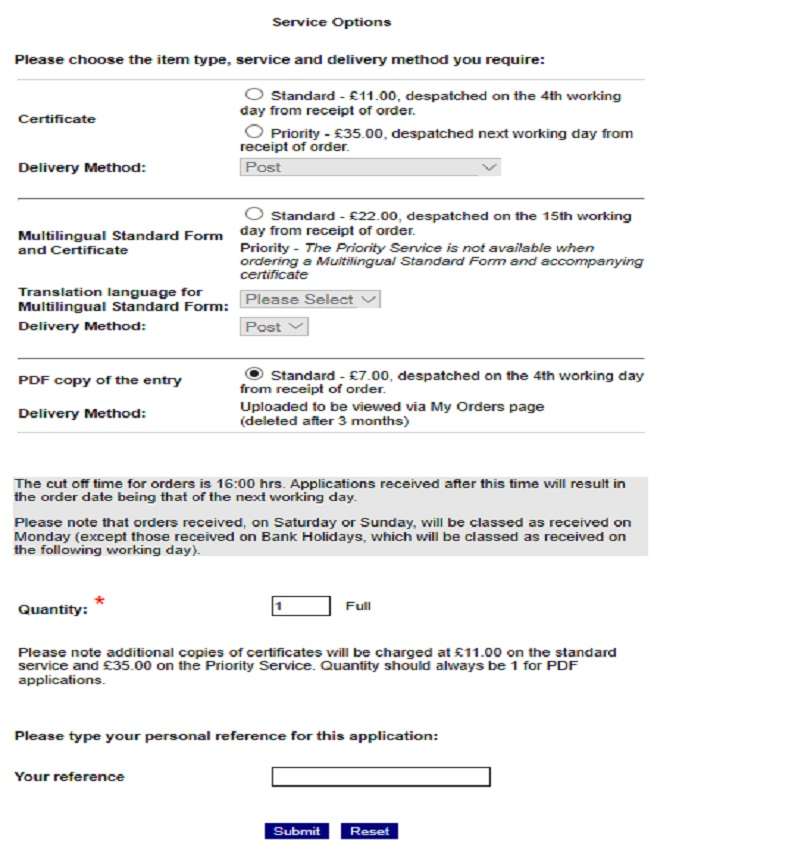
If ordering the PDF version, read the notes and then click to confirm and then click submit:
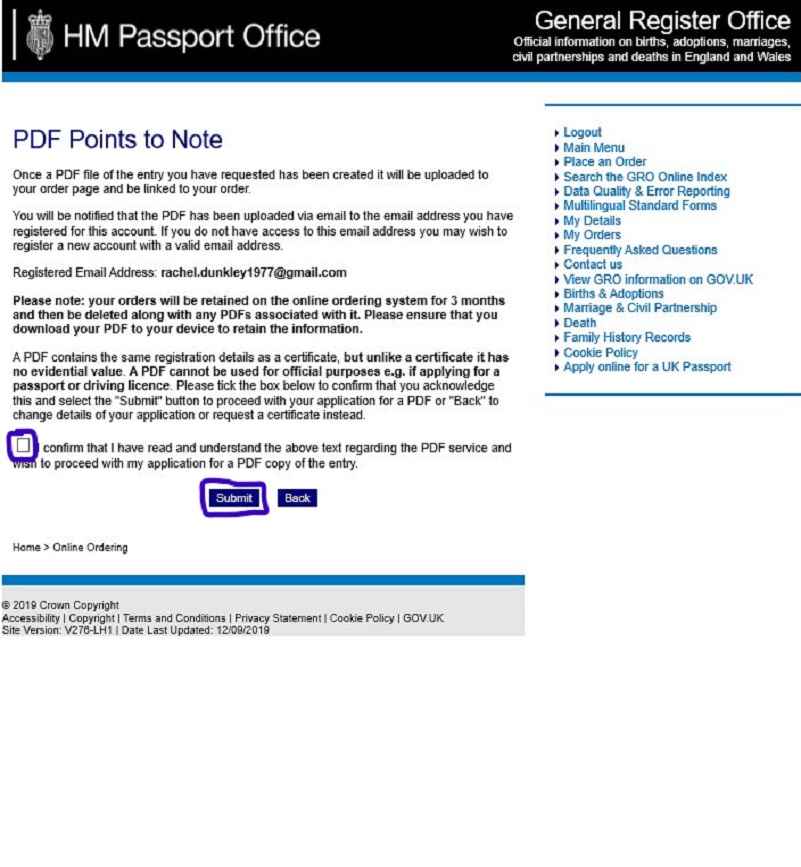
If ordering a paper copy, enter delivery address details (registered email address entered automatically, but I have hidden my email address)
Click Submit
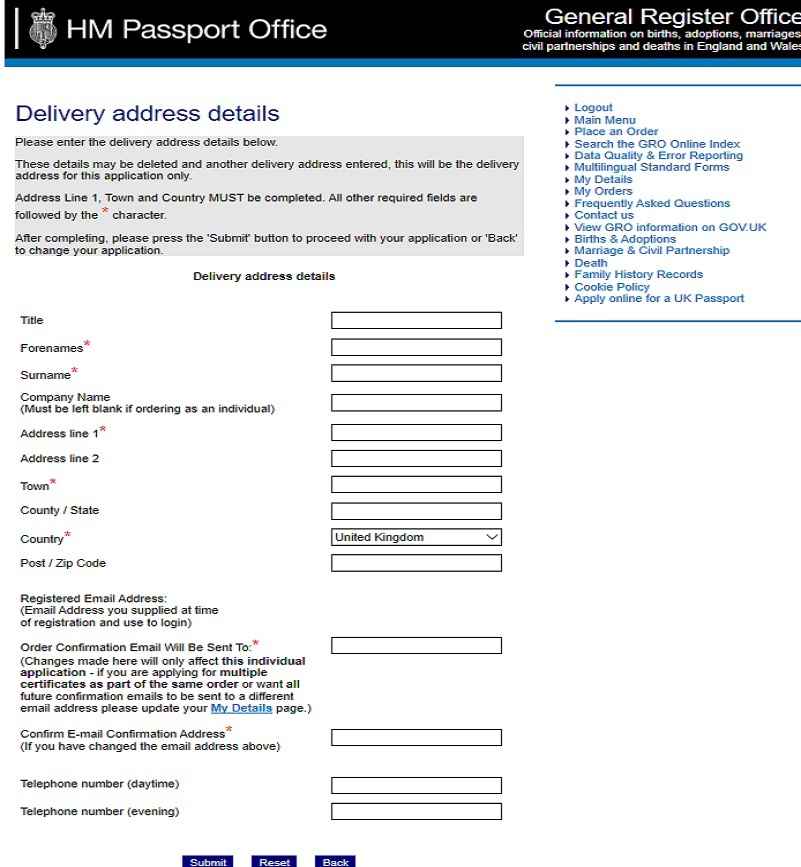
Check information entered for certificate is correct
Click Checkout:
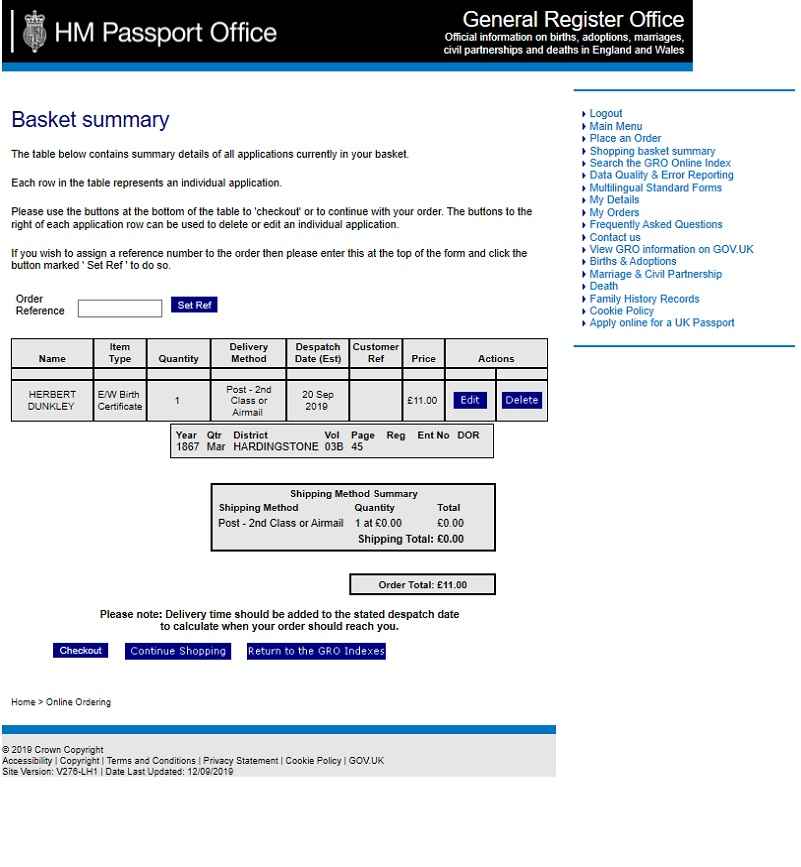
Check information is correct again and then click Confirm
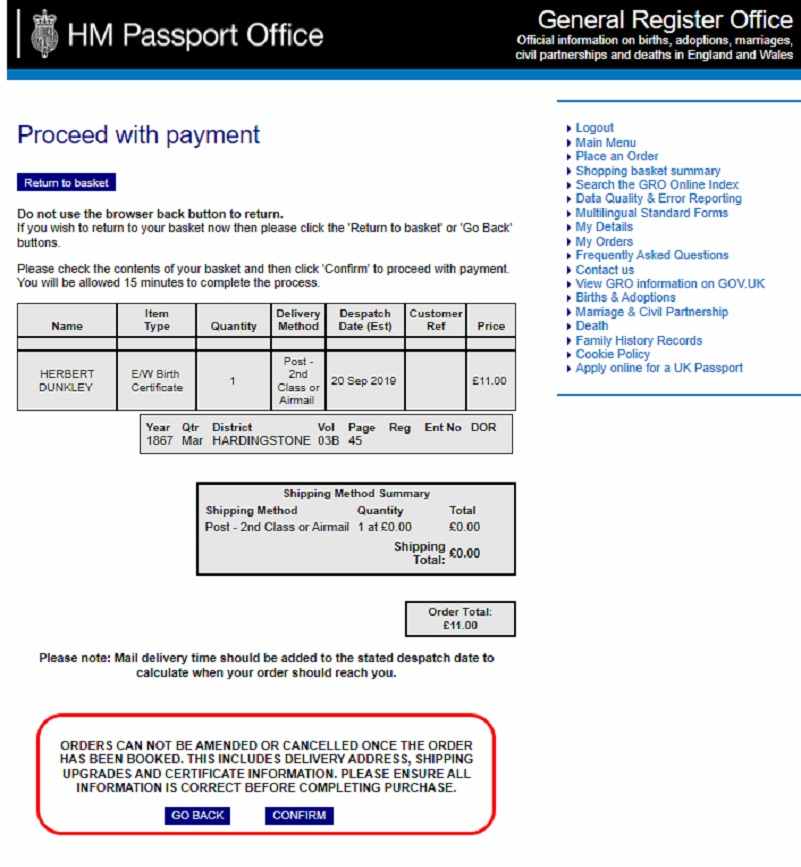
Enter your Payment Details:
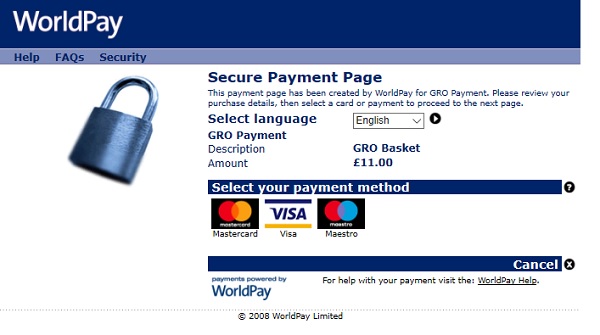
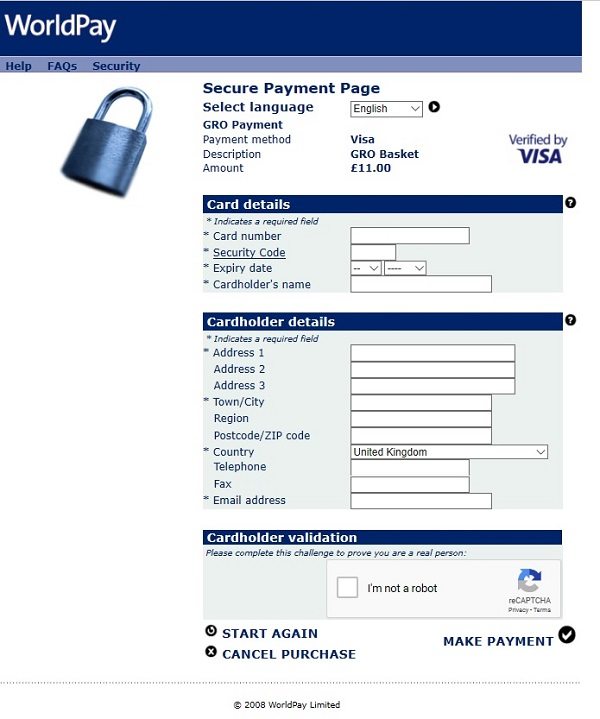
Using the GRO Index to Find a Person Born After 1934
If the person was born after 1934, follow the instructions below to order a birth certificate:
Some steps same as above:
Enter https://www.gro.gov.uk
Click Order certificates online
Click Search the GRO Historical Birth Indexes and Order Certificates/PDFs Online
Click register as an individual
Enter your email address, password and personal details
Click Place an Order on the screen after registration
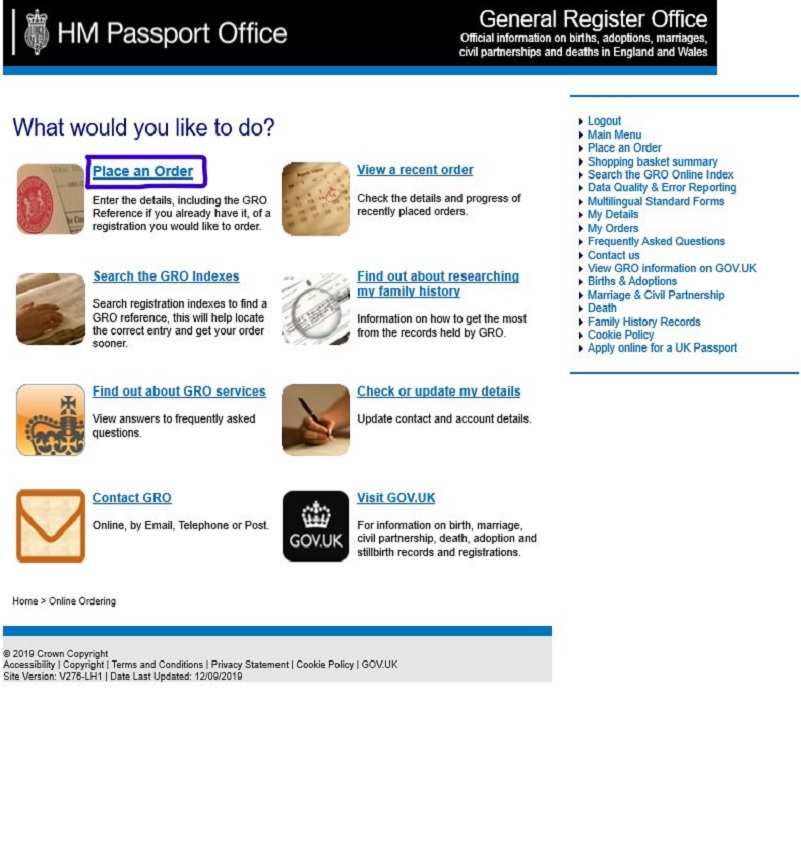
Click button beside appropriate area event was registered in.
Then state the type of event it was, in this case a birth.
Input year event was registered, stating that you know the GRO Index Reference in the next section.
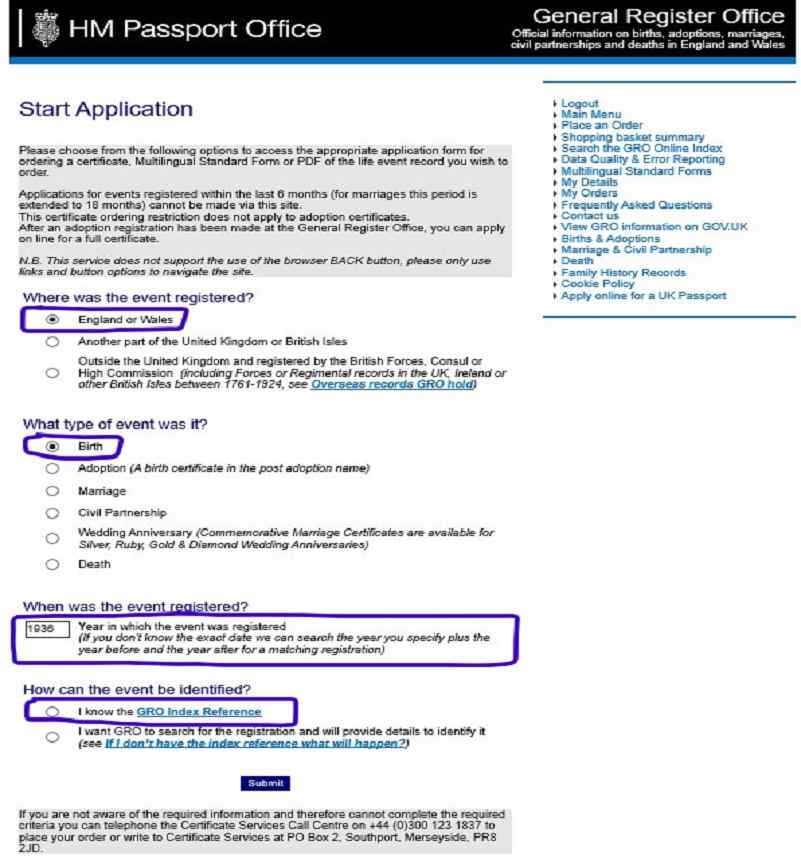
On the next page, enter their details and the Quarter, District Name, Volume Number and Page Number from the GRO Reference
Click whether you want the standard or priority service.
You can also enter a personal reference for your application if you wish.
Click Submit
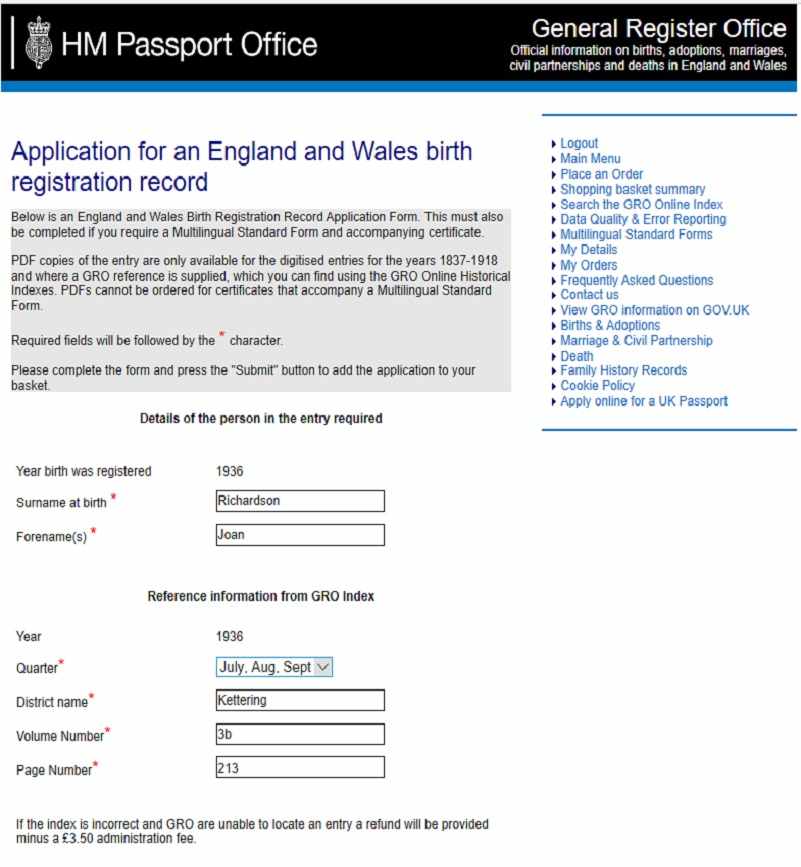
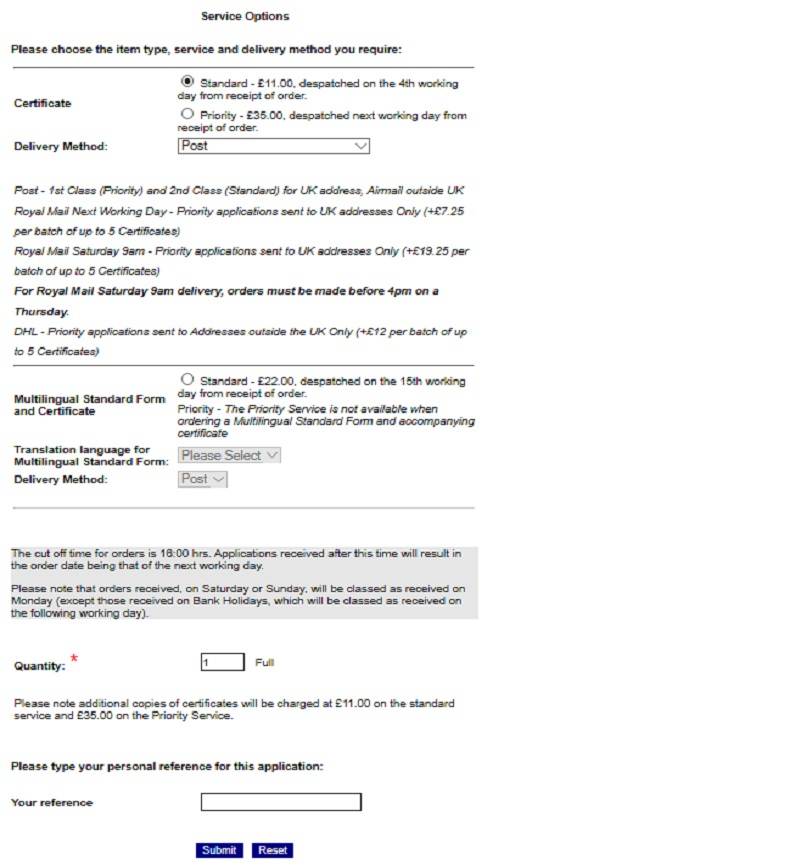
Same as above for certificates prior to 1918:
Enter delivery address details
Click Submit
Check information is correct
Click Checkout
Check information again
Click Confirm
Enter your payment details
The current cost is £11.00 per certificate. If you wish to use the priority service, where the certificate is dispatched the next working day following your application, the cost is £35.00. If you wish to purchase a birth certificate for someone born before 1919, you can purchase a PDF version of the certificate for £7.
You can also obtain a birth certificate from the appropriate register office, which is the Office where births, marriages and deaths are officially recorded.
Registers held by the Office date back to 1837, being in the custody of the Superintendent Registrar of the district.
Each registration district may have one or more registrars, each of them assuming responsibility for a sub-district.
